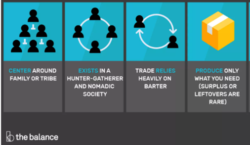Edited to fit newsletter
Traditional Economy:
Definition, Characteristics, and Examples
At first glance, the term “traditional economy” would appear to mean the market-focused U.S. economy Americans have experienced for hundreds of years. Yet a deeper look reveals a significantly different meaning of a traditional economy, one that relies more on culture, customs, and local history than dollars, cents, profits, and losses.
While certain elements are similar in traditional and capitalist economies (production, labor and trade are common), the gulf widens when you start looking at real-world examples of traditional economies. An economy where cows can replace cash and where communities can literally be on the move looking for better economic conditions has an interesting story to tell.

What Is a Traditional Economy?
A traditional economy is one which doesn’t operate under a profit motive..
Instead, it emphasizes the trading and bartering of products and services that enable participants to subsist in a specific region, community and/or culture. Largely, traditional economies are a way of life in underdeveloped countries that rely more on old-fashioned economic models like farming or hunting than on newer-age modes like industry and technology.
Traditional economies often develop over centuries, relying on the same time-proven economic drivers, like agriculture, fishing, hunting, and trading that a community’s ancestors used centuries ago. Economists use the term “completeness” to help define a traditional economy – one where all goods and services are consumed, and there is no excess or shortage of goods and services that drive a traditional economy.
Traditional Economy Compared With 3 Other Systems
To better define a traditional economy, it’s helpful to compare and contrast it with other major, historical global economies:
- Capitalist Economies – Historically, these societies leverage market forces, such as supply and demand, with a strong motivation to earn a profit, to shape their economic models.
- Socialist Economies – While socialism has been stretched in different directions by political partisans in recent years, its definition has remained stable over time. Basically, socialism is defined as an economic model where all citizens in a country, region, or community each own the factors of production equally. Typically, equal economic outcomes are generated after the election of a democratically chosen government.
- Communist Economies – Communism is an economic model where the collective, governed by a centralized government, owns any and all properties located in the collective. Communism is modeled upon a classless society, where the work of the citizenry – the fruits of their labor – are taken by the government and distributed throughout the populace based on need.
- Traditional Economy – This economy relies on tradition and culture to choose what goods and services will be produced, how those goods and services will be produced, and how those goods and services will be distributed throughout the populace – nothing is wasted.
History of Traditional Economies
Historically, traditional economies date all the way back to Cro-Magnon man, in fact, to the beginning of humankind.
That ageless culture largely holds true even today, as the Maasai continue to lead seminomadic lives, and continue to manage their lives via a traditional economy. Similar cultures, like the Inuit in Greenland and Alaska, and farming communities in Haiti and other island countries still largely practice a traditional economic model today.
Over time, though, traditional economies largely gave way to so-called command economies, where rulers (often unelected) in countries like Greece, Italy, and Egypt, made the primary economic decisions and the people followed.
Market economies, the model for capitalism, didn’t take hold until the 16th century, prospering in more developed nations like Germany and the U.K.
Advantages of a Traditional Economy
- Traditional economies breed strong, tight-knit communities where every member is either generating or supporting the production of goods and services.
- Traditional economies also create an environment where each member of the community is well aware of the importance of the role they play in contributing to the economy. This knowledge and awareness is then passed on to younger generations.
- Traditional economies produce no industrial pollution and keep their living environment clean. Usually only produce and take what they need, so there is no waste or inefficiencies involved in producing the goods.
Disadvantages of a Traditional Economy
- Traditional economies have to continually work to produce those goods to survive. There are no weekends off or vacations. To sustain a traditional economy means working hard with long hours, with no guarantee…
- A traditional economy isn’t as efficient as a market economy, which has a significantly stronger track record of success in guaranteeing a good quality of life for society members.
- In a traditional economy, specific roles are handed down from generation to generation. If your father was a hunter, you’ll be a hunter, too. Change is largely shunned, as it threatens a society’s chances of survival.
This was taken from a website – Original Article
